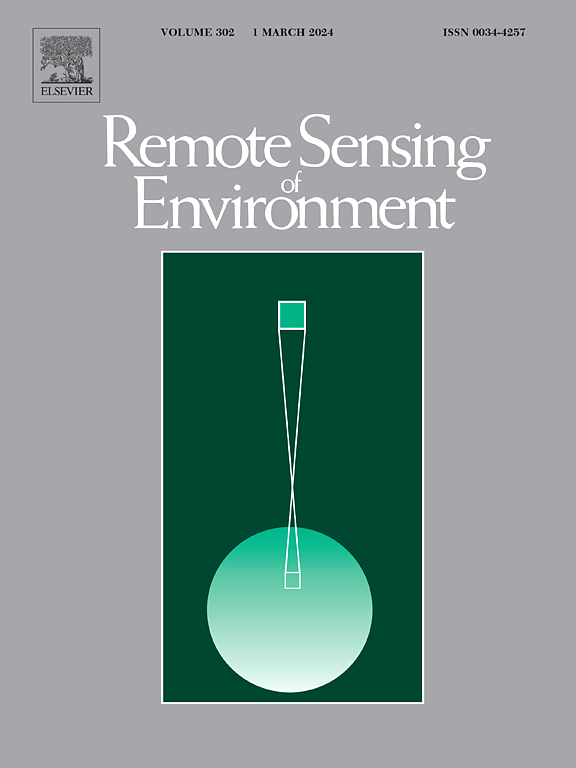Next generation Arctic vegetation maps: Aboveground plant biomass and woody dominance mapped at 30 m resolution across the tundra biome
IF 11.1
1区 地球科学
Q1 ENVIRONMENTAL SCIENCES
引用次数: 0
Abstract
The Arctic is warming faster than anywhere else on Earth, placing tundra ecosystems at the forefront of global climate change. Plant biomass is a fundamental ecosystem attribute that is sensitive to changes in climate, closely tied to ecological function, and crucial for constraining ecosystem carbon dynamics. However, the amount, functional composition, and distribution of plant biomass are only coarsely quantified across the Arctic. Therefore, we developed the first moderate resolution (30 m) maps of live aboveground plant biomass (g m−2) and woody plant dominance (%) for the Arctic tundra biome, including the mountainous Oro Arctic. We modeled biomass for the year 2020 using a new synthesis dataset of field biomass harvest measurements, Landsat satellite seasonal synthetic composites, ancillary geospatial data, and machine learning models. Additionally, we quantified pixel-wise uncertainty in biomass predictions using Monte Carlo simulations and validated the models using a robust, spatially blocked and nested cross-validation procedure. Observed plant and woody plant biomass values ranged from 0 to ∼6000 g m−2 (mean ≈ 350 g m−2), while predicted values ranged from 0 to ∼4000 g m−2 (mean ≈ 275 g m−2), resulting in model validation root-mean-squared-error (RMSE) ≈ 400 g m−2 and R2 ≈ 0.6. Our maps not only capture large-scale patterns of plant biomass and woody plant dominance across the Arctic that are linked to climatic variation (e.g., thawing degree days), but also illustrate how fine-scale patterns are shaped by local surface hydrology, topography, and past disturbance. By providing data on plant biomass across Arctic tundra ecosystems at the highest resolution to date, our maps can significantly advance research and inform decision-making on topics ranging from Arctic vegetation monitoring and wildlife conservation to carbon accounting and land surface modeling.


下一代北极植被图:在冻土带生物群系中以30米分辨率绘制地上植物生物量和木材优势度图
北极变暖的速度比地球上任何地方都要快,使苔原生态系统处于全球气候变化的最前沿。植物生物量是生态系统的基本属性,对气候变化敏感,与生态功能密切相关,对制约生态系统碳动态至关重要。然而,整个北极地区的植物生物量的数量、功能组成和分布只是粗略的量化。因此,我们开发了北极冻土带生物群系的第一个中等分辨率(30 m)的地上活植物生物量(g m−2)和木本植物优势度(%)地图,包括山区奥罗北极。我们使用新的综合数据集,包括野外生物量收获测量、Landsat卫星季节性合成复合材料、辅助地理空间数据和机器学习模型,对2020年的生物量进行了建模。此外,我们使用蒙特卡罗模拟量化了生物量预测中的像素不确定性,并使用鲁棒性、空间阻塞和嵌套交叉验证程序验证了模型。观测到的植物和木本植物生物量值范围为0 ~ ~ 6000 g m−2(平均值≈350 g m−2),而预测值范围为0 ~ ~ 4000 g m−2(平均值≈275 g m−2),导致模型验证的均方根误差(RMSE)≈400 g m−2,R2≈0.6。我们的地图不仅捕捉了整个北极地区与气候变化(例如,解冻天数)有关的植物生物量和木本植物优势的大尺度模式,而且还说明了当地地表水文、地形和过去扰动如何形成精细尺度模式。通过提供迄今为止最高分辨率的北极苔原生态系统植物生物量数据,我们的地图可以显著推进研究,并为从北极植被监测和野生动物保护到碳核算和陆地表面建模等主题的决策提供信息。
本文章由计算机程序翻译,如有差异,请以英文原文为准。
求助全文
约1分钟内获得全文
求助全文
来源期刊

Remote Sensing of Environment
环境科学-成像科学与照相技术
CiteScore
25.10
自引率
8.90%
发文量
455
审稿时长
53 days
期刊介绍:
Remote Sensing of Environment (RSE) serves the Earth observation community by disseminating results on the theory, science, applications, and technology that contribute to advancing the field of remote sensing. With a thoroughly interdisciplinary approach, RSE encompasses terrestrial, oceanic, and atmospheric sensing.
The journal emphasizes biophysical and quantitative approaches to remote sensing at local to global scales, covering a diverse range of applications and techniques.
RSE serves as a vital platform for the exchange of knowledge and advancements in the dynamic field of remote sensing.
 求助内容:
求助内容: 应助结果提醒方式:
应助结果提醒方式:


